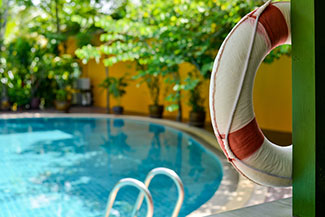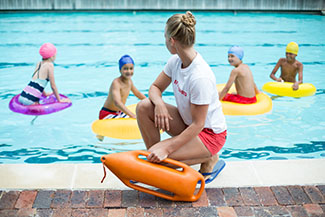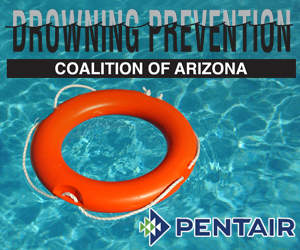Let Safety Rule Around the Pool
The ABCs and More of Protecting Children Around Swimming Pools
The Drowning Prevention Coalition of Arizona has worked hard to prevent drowning deaths since its founding in 1989. Back then the statistics were horrifying.
 According to the Arizona Department of Health Services, in the mid-1980s, Arizona ranked first among states in the drowning deaths of children ages 1 to 4. Since then the numbers have improved, but in recent years, the state still was fourth in this category. So far this year, one teenager and three small children have died in water-related accidents in the Phoenix area, according to fire departments in Maricopa and Pinal counties.
According to the Arizona Department of Health Services, in the mid-1980s, Arizona ranked first among states in the drowning deaths of children ages 1 to 4. Since then the numbers have improved, but in recent years, the state still was fourth in this category. So far this year, one teenager and three small children have died in water-related accidents in the Phoenix area, according to fire departments in Maricopa and Pinal counties.
Of course, Arizona has passed a law requiring homeowners to have child-proof, four-sided, locked fences for pools. "But a number of cities have their own laws that supersede the state law," Melissa Sutton, coalition president, told us. "In some cities you don't need a fence if you don't have a child living in the house that's under 6."
But proper fences for pools aren't the only measure that homeowners, parents and those caring for children should be concerned about. The coalition works to increase public awareness of the issue: promoting the role of swimming lessons in protection, urging training in CPR as a life-saving method, and getting homeowners to provide even more secure barriers around pools.
"There has to be more than one level of protection for children," Sutton said. "There have to be several layers."
So, the coalition is urging parents and other adults to "practice the ABCs and Ds" of water safety during swimming times:

"A" stands for adult supervision:
Rotate a designated water watcher/guardian to observe the pool for 15 to 20 minutes at a time so that a sober responsible adult is always watching children in a pool. That way they will remain attentive and alert and not get hot tired or distracted. When adults do get tired and leave their posts by the pool and a tragedy occurs, they often say later they went in the house for only 2 seconds. That's how a series of swimming lessons for tots got named "2seconds is 2 long."
"B" stands for using barriers to keep small children away from water:
It can be a locked fence around a pool or a closed door to a bathroom where a tub or toilet filled with water can be a danger. You can also install window and door alarms to warn you when a child is trying to get into a pool area.
"C" is for classes and Coast Guard approved life vests:
Everyone, including adults and older children, should take swimming lessons and CPR lessons. If children are non-swimmers or weak swimmers, they should wear Coast Guard approved life vests.
"D" is for having safe drains and proper grates to prevent underwater entrapment in swimming pools and spas:
Always teach children to stay away from grates and drains and replace any broken equipment of this kind. If you have an old drain or grate, replace the drain cover with one that complies with federal law.
To learn more about the law regarding pool and spa drains in a special paper produced by Pentair, a pool and aquatics company: What Every Commercial or Public Pool Operator Should Know
Resources:
Drowning Prevention Coalition of Arizona
What Every Commercial or Public Pool Operator Should Know
Water Safety & Drowning Prevention
July Home Maintenance To-Do | #2Seconds2Long
###

